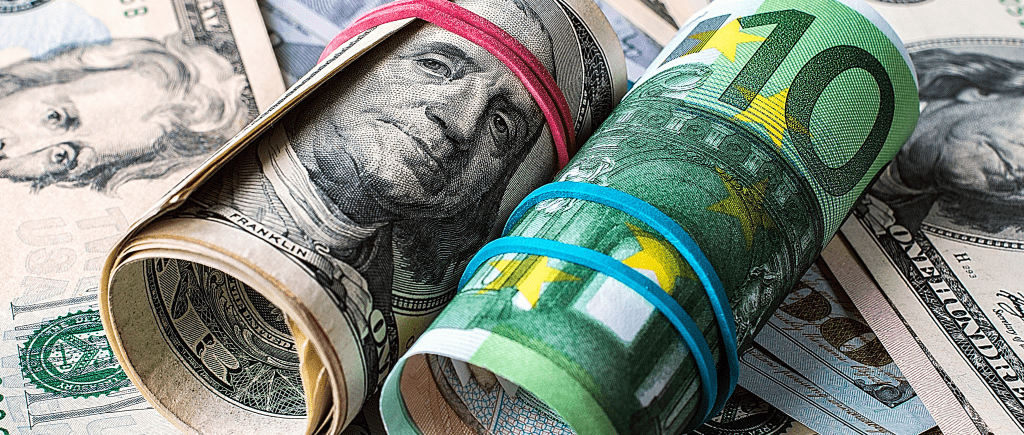The euro closed Monday’s trading higher rise, driven by an improvement in risk appetite cross financial markets, fresh German economic data, in addition to some other factors related to monetary policy.
Wall Street has seen intensive stock buying since the beginning of morning trading in the markets on the first day of trading in the new week, this eventually led to a decline in demand for the dollar and other safe haven assets after an improvement in risk appetite in the markets on the back of positive expectations of looming rate cuts by some major central authorities worldwide including the European Central Bank.
Remarks and statements by ECB officials have telegraphed that the central bank has room that may allow it to reduce interest rates, as inflation declines in the Eurozone. But ECB policymakers also stressed that this matter must be duly investigated and considered for a sufficient period of time before starting quantitative easing.
Talk about lowering interest rates often sparks optimism across most financial markets because lower interest rates provide a lot of flexibility in the investment environment that helps companies grow financially, which leads to stocks rising as any talk about lowering key rates spreads.
German data
The reading of the German Ifo Business Climate Index did not witness any change this May compared to the previous reading, which recorded 89.3 points, against expectations that indicated the possibility of an increase to 90.4 points. Growth in Germany, the largest economy in the Eurozone, also rose slightly by 0.2% in the first quarter of 2024 after the economy contracted in the last quarter of last year.
The euro’s main pair, versus the US dollar, rose to 1.0859, compared to the previous daily close of 1.0845. The pair fell to its lowest level on the first trading day of this week at 1.0840, compared to the highest level recorded at 1.0867.
Monetary policy
In addition to improving risk appetite and German data, statements came out from monetary policy makers at the European Central Bank that shed light on the possibility of starting to cut rates soon.
Joachim Nagel, Governor of the German Central Bank, suggested on Monday that the European interest rate cut might occur next June, ruling out that concerns about wage growth in the euro zone would affect this possible decision. European wage growth rose to 4.7% compared to the previous reading of 4.5%.
However, Nagel stressed that reducing interest rates in June does not necessarily mean that next month will witness a series of interest cut decisions, as each decision depends on fresh European data.
Eurozone Inflation and Interest Rate Expectations:
Eurozone inflation data is scheduled for release next Friday. Analysts anticipate that there will be no change in interest rate expectations for June. In April, the consumer price inflation index in the eurozone rose by 2.4%, and there are expectations that it will further increase to 2.5% this May.
European Central Bank Meeting and Rate Cut Possibility: On June 6, the European Central Bank (ECB) will convene. The ECB’s credibility is at stake, and the decision to cut interest rates is crucial. If implemented, it would be the first rate cut since March 2016. Christine Lagarde, Chair of the ECB’s Governing Council, recently emphasized the “great possibility” of a rate cut in June, expressing confidence in controlling inflation. These official signals strongly indicate an impending rate cut.
US Dollar Decline and Euro Strength:
The euro’s recent rise can be attributed to the weakening US dollar. The dollar has faced pressure due to global stock market gains and the euro’s strength. Despite the absence of significant market-moving events, the dollar index fell to 104.59 points from the previous daily close of 104.72 points. Conversely, the index reached a high of 104.76 points during Monday’s trading, compared to the lowest levels recorded at 104.57.
Impact of Stock Market Activity on the US Currency: The US currency has been under pressure since last Friday, driven by intense stock buying on Wall Street. This surge in stock demand contributed to a decline in demand for the dollar.
Key Data Points:
This week, crucial data points include indicators related to personal consumption expenditures. The Federal Reserve considers these indicators highly reliable for assessing inflation conditions in the country. Additionally, Eurozone and German inflation data will be released next Wednesday. These data sets will provide clarity on the future trajectory of federal and European interest rates, directly influencing the euro/dollar exchange rate.

 Noor Trends News, Technical Analysis, Educational Tools and Recommendations
Noor Trends News, Technical Analysis, Educational Tools and Recommendations




